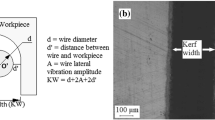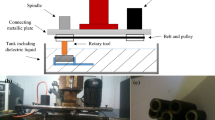Abstract
The wire electrical discharge machining is one of the best options for machining of high strength materials like Inconel 617. In this study, the effects of wire electrical discharge machining input parameters, such as pulse current and pulse duration on micro-hardness of machined surfaces and subsurface and also density of created surface cracks were investigated. Also the energy dispersive X-ray spectroscopy technique was used to elemental analysis of machined workpiece. The results of this study showed that increasing pulse current and pulse duration, decreases surface micro-hardness while subsurface micro-hardness is increased by increasing pulse duration. Also subsurface micro-hardness is increased by increasing pulse current up to 10 A, but after that the subsurface micro-hardness is decreased. According to the results, the micro-hardness of workpiece is reduced by increasing the distance from the top surface. Also the surface crack density is increased by increasing pulse current and pulse duration first, but it is decreased by increasing more of these two parameters.









Similar content being viewed by others
References
Li L, Guo YB, Wei XT, Li W (2013) Surface integrity characteristics in wire-EDM of Inconel 718 at different discharge energy. Procedia CIRP 6:220–225
Guo YB, Li W, Jawahir IS (2009) Surface integrity characterization and prediction in machining of hardened and difficult-to-machine alloys: a state-of-art research review and analysis. Mach Sci Technol 13(4):437–470
Li W, Guo YB (2012) A two-parameter method to monitor and characterize tool wear in end milling Inconel 718. In: Proc. of ASME international conference on manufacturing science and engineering, Notre Dame
Singh S, Maheshwari S, Pandey PC (2004) Some investigations into the electric discharge machining of hardened tool steel using different electrode materials. J Mater Process Technol 149(1–3):272–277
Wang Fei, Liu Yonghong, Zhang Yanzhen, Tang Zemin, Ji Renjie, Zheng Chao (2014) Compound machining of titanium alloy by super high speed EDM milling and arc machining. J Mater Process Technol 214(3):531–538
Pérez Delgado Y, De Baets P, Bonny K, Carretero Olalla V, Vleugels J, Lawers B, Staia MH (2013) Influence of wire-EDM on high temperature sliding wear behavior of WC10Co(Cr/V) cemented carbide. Int J Refract Metals Hard Mater 41:198–209
Luis CJ, Puertas I (2007) Methodology for developing technological tables used in EDM processes of conductive ceramics. J Mater Process Technol 189(1–3):301–309
Klocke F, Welling D, Klink A, Veselovac D, Nöthe T, Perez R (2014) Evaluation of advanced wire-EDM capabilities for the manufacture of fir tree slots in Inconel 718. Procedia CIRP 14:430–435
Klocke F, Welling D, Klink A, Perez R (2014) Quality assessment through in-process monitoring of wire-EDM for fir tree slot production. Procedia CIRP 24:97–102
Clijsters S, Liu K, Reynaerts D, Lauwers B (2010) EDM technology and strategy development for the manufacturing of complex parts in sisic. J Mater Proc Technol 210:631–641
Klink A, Guo YB, Klocke F (2011) Surface integrity evolution of power metallurgical tool steel by main cut and finishing trim cuts in wire-EDM. Procedia Eng 19:178–183
Yang RT, Tzeng CJ, Yang YK (2012) Optimization of wire electrical discharge machining process parameters for cutting tungsten. Int J Adv Manuf Technol 60(1):135–147
Aspinwall DK, Soo SL, Walder G (2008) Workpiece surface roughness and integrity after WEDM of Ti–6Al–4V and Inconel 718 using minimum damage generator technology. Ann CIRP 57(1):187–190
Khan AR, Rahman MM, Kadirgama K, Maleque MA (2011) Prediction of surface roughness of Ti–6Al–4V in electrical discharge machining : a regression model. JMES 1:16–24
Lee HT et al (1996) Influence of EDM process parameters on surface defects and roughness. Chin J Mater Sci 28(4):270–278
Lee HT, Yur JP (2000) Characteristic analysis on EDMed surfaces using Taguchi method approach. Mater Manuf Process 15(6):781–806
Tung WH (1998) The relationship between white layer and residual stress induced by EDM hole-drilling. Master thesis, Department of Mechanical Engineering, National Cheng Kung University, Tainan
Lin PC (1998) Study of residual stress induced by EDM hole-drilling. Master thesis, Department of Mechanical Engineering, National Cheng Kung University, Tainan
Author information
Authors and Affiliations
Corresponding author
Additional information
Technical Editor: Márcio Bacci da Silva.
Rights and permissions
About this article
Cite this article
Shabgard, M., Farzaneh, S. & Gholipoor, A. Investigation of the surface integrity characteristics in wire electrical discharge machining of Inconel 617. J Braz. Soc. Mech. Sci. Eng. 39, 857–864 (2017). https://doi.org/10.1007/s40430-016-0556-0
Received:
Accepted:
Published:
Issue Date:
DOI: https://doi.org/10.1007/s40430-016-0556-0




